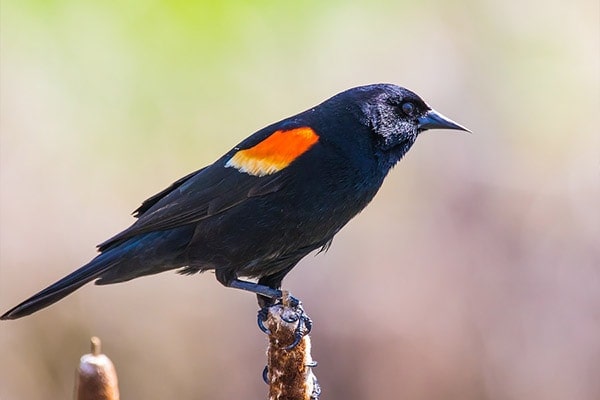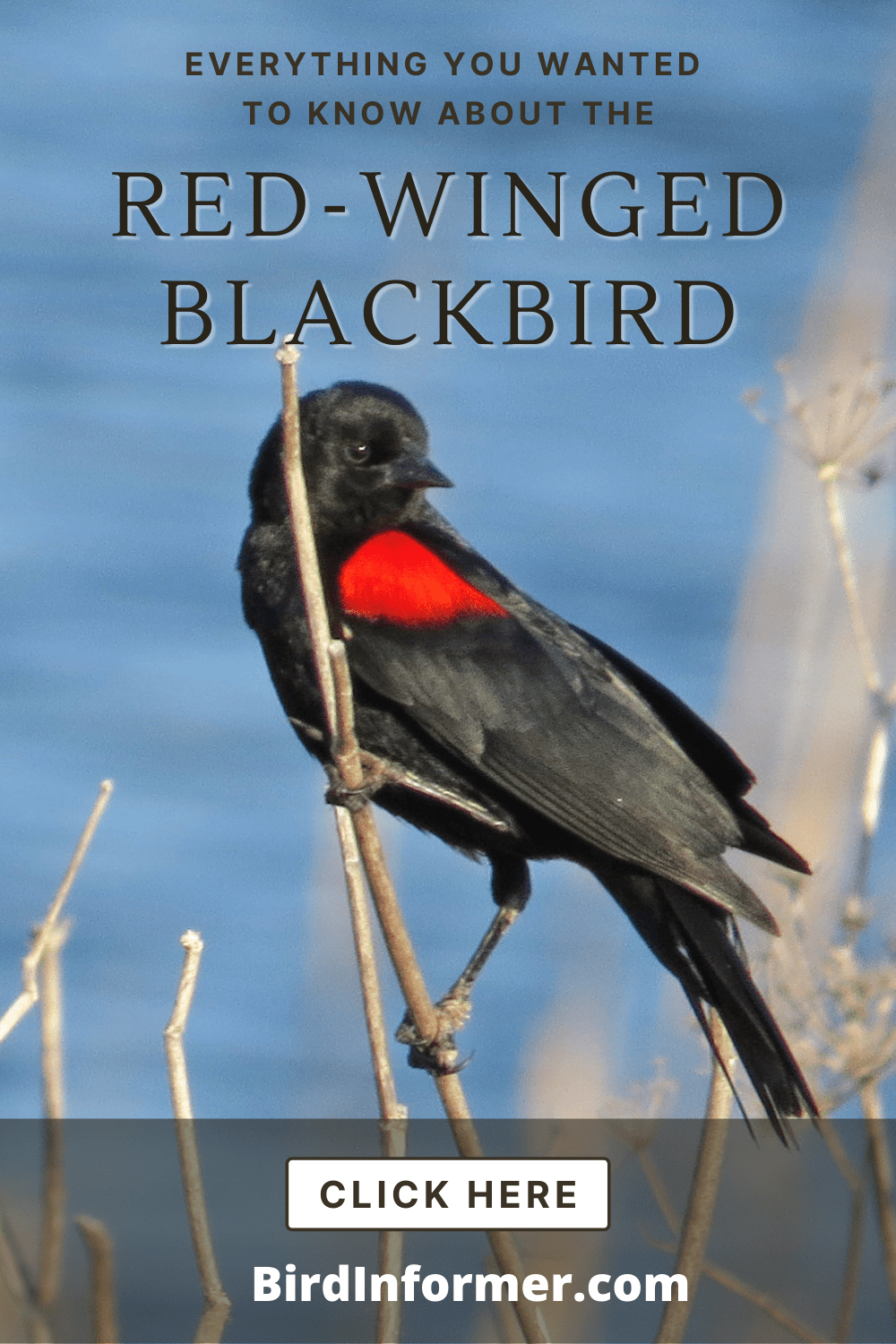Contents
- Red-winged blackbird facts
- Red-winged blackbird: how-to identify
- Red-winged blackbird bird vocalization
- Where You’ll See Red-Winged Blackbirds
- Red-winged blackbird diet
- Red-winged blackbird nesting
- Red-winged blackbird behavior
- How-to attract red-winged blackbirds
- Red-winged blackbird threats
- Red-winged blackbird fun & interesting facts
- Red-winged blackbird related species in this family
The Red-winged Blackbird is known to be one of the most abundant bird species across North America. Their beautiful glossy black bodies with red patches are a great sight to see in summer. You’ll also often see them gathered in flocks by the roadsides and even in telephone wires, sometimes even with other bird species.
In this article, we are going to cover a wide variety of topics related to the Red-winged Blackbird, such as:
- How to identify them
- How, when, and where they migrate
- Their diet
- How and where they nest
- And much more…
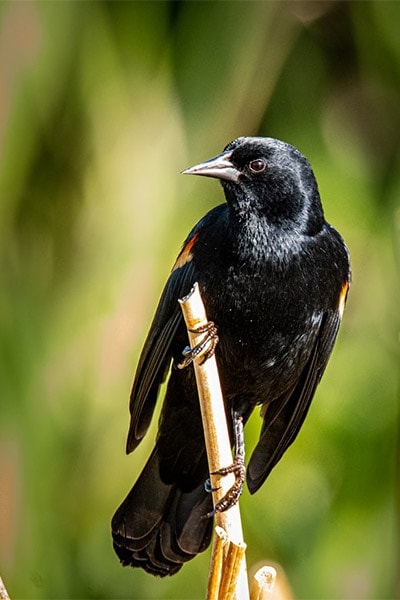
So, without any more delay…
Let’s jump right into it and learn more about the Red-winged Blackbird.
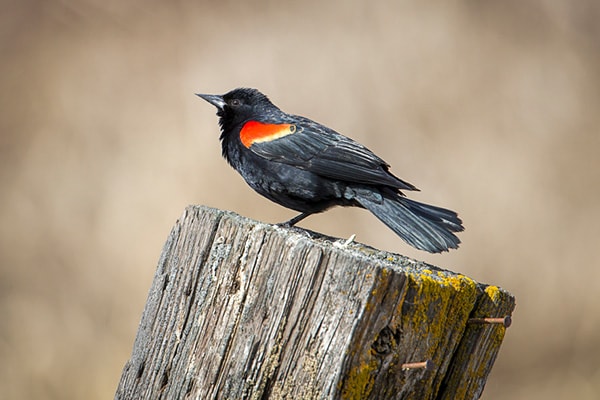
Red-winged blackbird facts
- Common Name: Red-winged Blackbird
- Scientific Name: Agelaius phoeniceus
- Scientific Family: Icteridae
- Life Span: 2 years
- Size: 6.7 to 9.1 inches
- Wingspan: 12.2 to 15.8 inches
- Weight: 1.1 to 2.7 oz
- Conservation status: Least Concern (LC)
Red-winged blackbird: how-to identify
Red-winged Blackbirds are medium-sized birds that are about 7.25 inches in length. They also feature a broad shoulder, a sharp, pointed bill, and a slightly longer tail.
Differences Between Male & Female
Male and female Red-winged Blackbirds look very different from each other. The name “Red-winged Blackbirds” would more likely pertain to the males because of their glossy black-colored bodies with red and yellow patches on their shoulders.
Female birds, on the other hand, are brownish. Their upper body is a combination of brown and white that looks clean, while their underparts are heavily streaked. Sometimes, you’ll notice a yellow tinge on their faces and throat area.
Differences In Summer Plumage vs Winter Plumage
Between the male and female Red-winged Blackbirds, only the males show a difference in plumage between the winter and summer seasons.
In winter, the males don’t look as bright or glossy as they are during the breeding season. You’ll notice that they look more scaly rather than just a clean black color throughout. The red and yellow patches on the shoulder are also not as recognizable.
Red-winged blackbird bird vocalization
Where You’ll See Red-Winged Blackbirds
Red-winged Blackbirds are widespread across North America.
Their breeding range extends from southern Alaska, going across south Yukon and Northwest territories, reaching all of Canada up to the southern portions of Quebec. The birds are also seen across the United States all-year-round, with northern populations traveling down south for winter to Mexico and Guatemala.
These birds can live in any type of habitat, but they love wetlands the best, including fresh and saltwater marshes and rice paddies. Sometimes, you’ll also find them in drier areas like the meadows, agricultural fields, pastures, and even in lightly wooded deciduous forests.
Red-winged blackbird bird migration
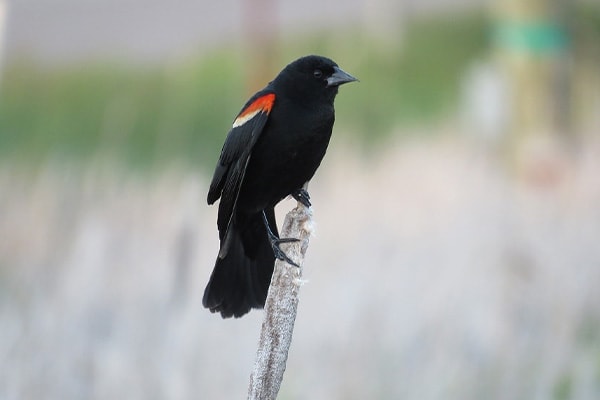
Southern populations of Red-winged Blackbirds are considered resident birds as they don’t have to travel for winter. Northern populations, on the other hand, need to travel down south for winter around September and October.
Red-winged blackbird diet
The Red-winged Blackbirds diet varies depending on the season.
During summer, the birds would mainly eat insects as they need enough energy for breeding. Some of the insects they would eat are beetles, caterpillars, spiders, millipedes, grasshoppers, and snails.
In winter, the birds would switch to eating seeds of grasses and weeds as these are more abundant than insects. They would eat some fruits and berries.
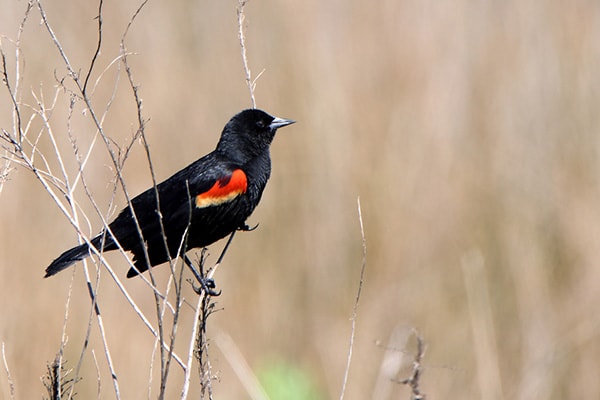
Red-winged blackbird nesting
- Clutch Size: 2-4 eggs
- # of Broods: 1-2 broods
- Incubation Period: 11-13 days
- Nestling Period: 11-14 days
- Egg Description: Pale blue-green to gray with black or brown markings
Red-winged Blackbirds are known to be highly polygamous, with males nesting with five females on average. But there have also been observations where there are 15 females in one male nesting territory.
Breeding season usually starts around spring and ends around mid-summer. Nest locations are often chosen by the females and are generally on low elevations. This includes vegetation, shrubs, and wetlands.
The female builds the nest, and it’s a bulky, open cup made from several plant materials like grass, reeds, leaves, and rootlets winded up together. She then plasters everything with mud and lines it with softer materials like fine grass.
Red-winged blackbird behavior
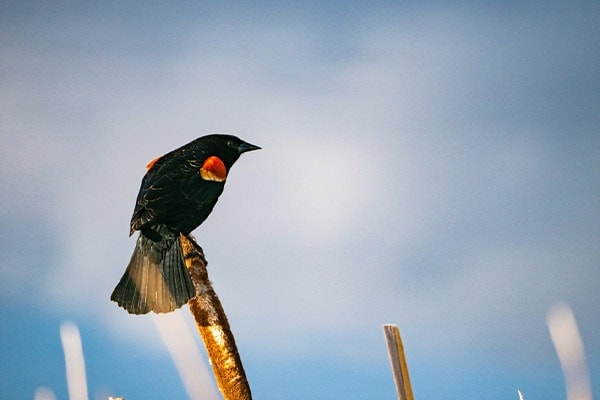
Red-winged Blackbirds, like many migratory birds, are strong fliers. These birds migrate in large flocks and would rest together in large groups, as well. This is especially during the winter or fall.
During the breeding season, male birds become aggressive to defend their breeding territories. However, it has also been noted that fighting among each other is not common.
These birds are most active during the day, searching for food. They usually forage while walking on the ground and sometimes flying up in shrubs and trees.
How-to attract red-winged blackbirds
Red-winged Blackbirds are widespread across the United States. In fact, the majority of their population in the US are resident birds, meaning they stay in their area all-year-round.
These birds are frequent visitors of backyard feeders. If you want to attract them, open-style feeders are the most ideal to use. This includes the platform and hopper feeders. Fill these feeders with their favorite seeds, specifically sunflower seeds, corn, and peanuts.
You can then plant some shrubs or small trees around your backyard that may serve as shelter or nesting sites for the birds. Lastly, don’t forget to place a birdbath as a water source for the birds.
Red-winged blackbird threats
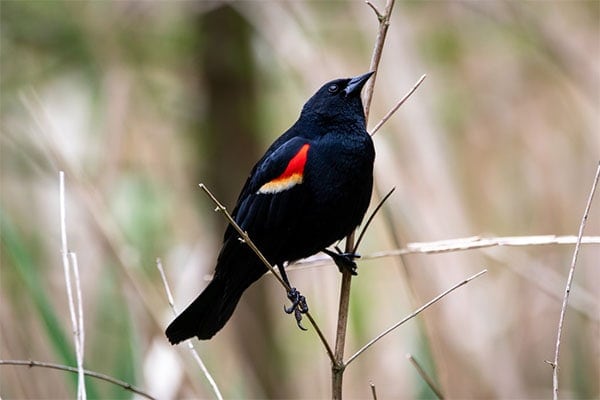
Red-winged Blackbirds are one of the most abundant birds in North America despite a decline in their numbers. No significant threat is seen, but they sure are hunted down by many predators, including raccoons, minks, magpies, wrens, owls, and raptors.
Red-winged blackbird fun & interesting facts
- Red-winged Blackbirds can travel at a speed of over 30 mph.
- They are called “memiskondinimaanganeshiinh” in several Ojibwa languages; this translates to “a bird with very red shoulder-blade.”
- These are highly polygamous birds, with males having 15 female mates.
- Males are highly territorial during the breeding season and would spend most of their day defending their territory.
- The oldest recorded Red-winged Blackbird was 15 years and nine months old.
- Yellow-headed Blackbird
- Bobolink
- Western Meadowlark
- Eastern Meadowlark
- Orchard Oriole
- Hooded Oriole
- Bullock’s Oriole
- Spot-breasted Oriole
- Altamira Oriole
- Audubon’s Oriole
- Baltimore Oriole
- Scott’s Oriole
- Tricolored Blackbird
- Shiny Cowbird
- Bronzed Cowbird
- Brown-headed Cowbird
- Rusty Blackbird
- Brewer’s Blackbird
- Common Grackle
- Boat-tailed Grackle
- Great-tailed

